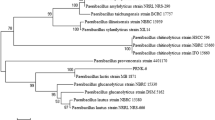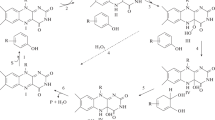Abstract
The aerobic metabolism of monofluorophenols (mono-FPs) by the actinomycete, Pseudonocardia benzenivorans, was studied. This strain was able to grow on 4-fluorophenol (4-FP) and readily transform 2- and 3-fluorophenol to the corresponding metabolites. The detailed mechanism of mono-FPs degradation by P. benzenivorans was elucidated from enzymatic assays and the identification of reaction intermediates by high-performance liquid chromatography (HPLC) and gas chromatography–mass spectrometry. Two types of fluorocatechols (i.e., 3- and 4-fluorocatechol) were identified as the key transformation products. During 4-FP degradation, only 4-fluorocatechol was detected, and a stoichiometric level of fluoride was released. Both fluorocatechols were observed together in cultures containing 3-fluorophenol (3-FP), while only 3-fluorocatechol was found to accumulate in 2-fluorophenol (2-FP)-containing cultures. Whole-cell extracts of P. benzenivorans expressed catechol 1,2-dioxygenase activity, indicating that the transformation of the three tested mono-FPs proceeded via ortho-cleavage pathway. The results presented in this paper provide comprehensive information regarding the metabolism of mono-FPs by a single bacterium.




Similar content being viewed by others
References
Bartels I, Knackmuss HJ, Reineke W (1984) Suicide inactivation of catechol 2, 3-dioxygenase from Pseudomonas putida mt-2 by 3-halocatechols. Appl Environ Microbiol 47:500–505
Boesmna MG, Dinarieva TY, Middlehoven WJ, Van Berkel WJH, Doran J, Vervoort J, Rietjens IMCM (1998) 19F nuclear magnetic resonance as a tool to investigate microbial degradation of fluorophenols to fluorocatechols and fluoromuconates. Appl Environ Microbiol 64:1256–1263
Boersma MG, Solyanikova IP, Van Berkel WJH, Vervoort J, Golovleva L, Rietjens IMCM (2001) 19F NMR metabolomics for the elucidation of microbial degradation pathways of fluorophenols. J Ind Microbiol Biotechnol 26:22–34
Bondar VS, Boersma MG, Golovlev EL, Vervoort J, Van Berkel WJH, Finkelstein ZI, Solyanikova IP, Golovleva LA, Rietjens IMCM (1998) 19F NMR study on the biodegradation of fluorophenols by various Rhodococcus species. Biodegradation 9:475–486
Bondar VS, Boersma MG, Van Berkel WJH, Finkelstein ZI, Golovlev EL, Baskunov BP, Vervoort Golovleva LA, Rietjens IMCM (1999) Preferential oxidative dehalogenation upon conversion of 2-halophenols by Rhodococcus opacus 1G. FEMS Microbiol Lett 181:73–82
Broderick JB (1999) Catechol dioxygenases. Essays Biochem 34:173–189
Buhler DR, Unlu F, Thakker DR, Slaqa TJ, Conney AH, Wood AW, Chang RL, Levin W, Jerina DM (1983) Effect of a 6-fluoro substituent on the metabolism and biological activity of benzo(a)pyrene. Cancer Res 43:1541–1549
Carvalho MF, Alves CCT, Ferreira MIM, De Marco P, Castro PML (2002) Isolation and initial characterization of a bacterial consortium able to mineralize fluorobenzene. Appl Environ Microbiol 68:102–105
Carvalho MF, Ferreira MIM, Moreira IS, Castro PML, Janssen DB (2006) Degradation of fluorobenzene by Rhizobiales strain F11 via ortho cleavage of 4-fluorocatechol and catechol. Appl Environ Microbiol 72:7413–7417
Chaojie Z, Qi Z, Ling C, Yuan Y, Hui Y (2007) Degradation of mono-fluorophenols by an acclimated activated sludge. Biodegradation 18:51–61
Dorn E, Knackmuss HJ (1978) Chemical structure and biodegradability of halogenated aromatic compounds. Substituent effects on 1, 2 dioxygenation of catechol. Biochem J 174:85–94
Engesser KH, Rubio MA, Ribbons DW (1988) Bacterial metabolism of side chain fluorinated aromatics: cometabolism of 4-trifluoromethyl(TFM)-benzoate by 4-isopropylbenzoate grown Pseudomonas putida JT strains. Arch Microbiol 149:198–206
Ferreira MIM, Marchesi JR, Janssen DB (2008) Degradation of 4-fluorophenol by Arthrobacter sp. strain IF1. Appl Microbiol Biotechnol 78:709–717
Finkelstein ZI, Baskunov BP, Boersma MG, Vervoort J, Golovlev EL, Van Berkel WJH, Golovleva LA, Rietjens IMCM (2000) Identification of fluoropyrogallols as new intermediates in biotransformation of monofluorophenols in Rhodococcus opacus 1cp. Appl Environ Microbiol 66:2148–2153
Fortnagel P, Harms H, Wittich RM, Krohn S, Meyer H, Sinnwell V, Wilkes H, Francke W (1990) Metabolism of dibenzofuran by Pseudomonas sp. strain HH69 and the mixed culture HH27. Appl Environ Microbiol 56:1148–1156
Gibson DT (1968) Microbial degradation of aromatic compounds. Science 161:1093–1097
Gorlatov SN, Golovleva LA (1992) Effect of cosubstrates on the dechlorination of selected chlorophenolic compounds by Rhodococcus erythropolis 1CP. J Basic Microbol 32:177–184
Gurujeyalakshmi G, Oriel P (1989) Isolation of phenol-degrading Bacillus stearothermophilus and partial characterization of the phenol hydroxylase. Appl Environ Microbiol 55:500–502
Haggblom M (1990) Mechanisms of bacterial degradation and transformation of chlorinated monoaromatic compounds. J Basic Microbiol 30:115–141
Haggblom MM, Bossert ID (2003) Dehalogenation: microbial processes and environmental applications, 1st edn. Springer, New York, pp 19–32
Hofrichter M, Bublitz F, Fritsche W (1994) Unspecific degradation of halogenated phenols by the soil fungus Penicillium frequentans Bi 7/2. J Basic Microbiol 34:163–172
Kampfer P, Kroppenstedt RM (2004) Pseudonocardia benzenivorans sp. nov. Int J Syst Evol Microbiol 54:749–751
Key BD, Howell RD, Criddle CS (1997) Fluorinated organics in the biosphere. Environ Sci Technol 31:2445–2454
Mahendra S, Alvarez-Cohen L (2006) Kinetics of 1, 4-dioxane biodegradation by monooxygenase-expressing bacteria. Environ Sci Technol 40:5435–5442
Marr J, Kremer S, Sterner O, Anke H (1996) Transformation and mineralization of halophenols by Penicillium simplicissimum SK9117. Biodegradation 7:165–171
Mars AE, Kasberg T, Kaschabek SR, Van Agteren MH, Janssen DB, Reineke W (1997) Microbial degradation of chloroaromatics: use of the meta-cleavage pathway for mineralization of chlorobenzene. J Bacteriol 179:4530–4537
Nozaki M (1970) Metapyrocatechase (Pseudomonas). Meth Enzymol 17A:522–525
Oltmanns RH, Muller R, Otto MK, Lingens F (1989) Evidence for a new pathway in the bacterial degradation of 4-fluorobenzoate. Appl Environ Microbiol 55:2499–2504
Park BK, Kitteringham NR, O'Neill PM (2001) Metabolism of fluorine-containing drugs. Annu Rev Pharmacol Toxicol 41:443–470
Schreiber A, Hellwiq M, Dorn E, Reineke W, Knackmuss HJ (1980) Critical reactions in fluorobenzoic acid degradation by Pseudomonas sp. B13. Appl Environ Microbiol 39:58–67
Thakker DR, Yagi H, Sayer JM (1984) Effects of a 6-fluoro substituent on the metabolism of benzo(a)pyrene 7, 8-dihydrodiol to bay-region diol epoxides by rat liver enzymes. J Biol Chem 259:11249–11256
Van Pee KH, Unversucht S (2003) Biological dehalogenation and halogenation reactions. Chemosphere 52:299–312
Whalen MY, Armstrong SM, Patel TR (1993) Characterization of a Rhodococcus species that utilizes numerous aromatics. Soil Biol Biochem 25:759–762
Zaitsev GM, Surovtseva EG (2000) Growth of Rhodococcus opacus on mixtures of monohalogenated benzenes and phenols. Microbiology 69:401–405
Zaitsev GM, Uotila JS, Tsitko IV, Lobanok AG, Salkinoja-Salonen MS (1995) Utilization of halogenated benzenes, phenols, and benzoates by Rhodococcus opacus GM-14. Appl Environ Microbiol 61:4191–4201
Acknowledgments
This research was supported by the Korean Science and Engineering Foundation (KOSEF) grant funded by the Korean government (MEST; No. R01-2008-000-20244-0) and “The GAIA project” from the Korea Ministry of Environment.
Author information
Authors and Affiliations
Corresponding author
Rights and permissions
About this article
Cite this article
Kim, EJ., Jeon, JR., Kim, YM. et al. Mineralization and transformation of monofluorophenols by Pseudonocardia benzenivorans . Appl Microbiol Biotechnol 87, 1569–1577 (2010). https://doi.org/10.1007/s00253-010-2647-7
Received:
Revised:
Accepted:
Published:
Issue Date:
DOI: https://doi.org/10.1007/s00253-010-2647-7




